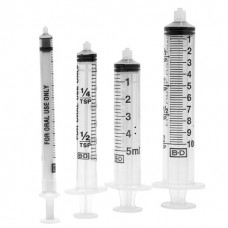BD SYRINGE 3ML LUER LOCK, BOX/100 (302113)
- Brand: BD
- Product Code: 302113
-
Ex GST: AU$20.00
BD SYRINGE 3ml LUER LOCK Box/100
Features
- Clear barrel for perfect visualisation
- 2-piece syringes with Luer Lock
- Smooth plunger movement, lower sliding force
- Retaining ring which prevents accidental plunger rod withdrawal
- Leak-tight test meets the standards
- Accurate scale marking graduation suited to user's needs
- Design of finger grip flanges which ensures stability and comfort during injection
- Ergonomically designed plunger for single-handed operation
- Barrel material made of Polypropylene
- Plunger material made of Polyethylene
- Plunger lubricated with Oleamide
- Units are colour-coded
- Ethylene oxide used for sterilization
- Sterile single packing, single use, latex-free, PVC-free
General Information
A syringe is a simple pump consisting of a plunger that fits tightly in a tube. The plunger can be pulled and pushed along inside a cylindrical tube (called a barrel), allowing the syringe to take in and expel a liquid or gas through an orifice at the open end of the tube. The open end of the syringe may be fitted with a hypodermic needle, a nozzle, or tubing to help direct the flow into and out of the barrel. Syringes are often used to administer injections, insert intravenous drugs into the bloodstream, apply compounds such as glue or lubricant, and measure liquids.
The word "syringe" is derived from the Greek σύριγξ (syrinx, meaning "tube") via back-formation of a new singular from its Greek-type plural "syringes" (σύριγγες).
Sectors in the syringe and needle market include disposable and safety syringes, injection pens, needleless injectors, insulin pumps and specialty needles. Hypodermic syringes are used with hypodermic needles to inject liquid or gases into body tissues, or to remove from the body. Injecting of air into a blood vessel is hazardous, as it may cause an air embolism; preventing embolisms by removing air from the syringe is one of the reasons for the familiar image of holding a hypodermic syringe upside down, tapping it, and expelling a small amount of liquid before an injection into the bloodstream.
The barrel of a syringe is made of plastic or glass, and usually has graduated marks indicating the volume of fluid in the syringe, and is nearly always transparent. Glass syringes may be sterilized in an autoclave. However, most modern medical syringes are plastic with a rubber piston, because this type seals much better between the piston and the barrel and because they are cheap enough to dispose of after being used only once, reducing the risk of spreading blood-borne diseases. Re-use of needles and syringes has caused spread of diseases, especially HIV and hepatitis among intravenous drug users. Syringes are, however, commonly re-used by diabetics and this is safe, if the syringe is only used by one person. In medical settings, single-use needles and syringes effectively reduce the risk of cross-contamination.
Medical syringes are sometimes used without a needle for orally administering liquid medicines to young children or animals, or milk to small young animals, because the dose can be measured accurately, and it is easier to squirt the medicine into the subject's mouth instead of coaxing the subject to drink out of a measuring spoon.
Different Tip Designs
Syringes come with a number of designs for the area in which the blade locks to the syringe body. Perhaps the most well know of these is the Luer lock, which simply twists the two together.
Bodies featuring a small, plain connection are known as slip tips and are useful for when the syringe is being connected to something not featuring a screw lock mechanism.
Similar to this is the catheter tip, which is essentially a slip tip but longer and tapered, making it good for pushing into things where there the plastic taper can form a tight seal. These can also be used for rinsing out wounds or large abscesses in veterinary use.
There is also an eccentric tip, where the nozzle at the end of the syringe is not in the centre of the syringe but at the side. This causes the blade attached to the syringe to lie almost in line with the walls of the syringe itself and they are used when the blade needs to get very close to parallel with the skin (when injecting into a surface vein or artery for example).
Standard U-100 insulin syringes
Insulin syringes are marked in insulin "units".
Syringes for insulin users are designed for standard U-100 insulin. The dilution of insulin is such that 1 mL of insulin fluid has 100 standard "units" of insulin. Since insulin vials are typically 10 mL, each vial has 1000 units.
Insulin syringes are made specifically for self injections and have friendly features:
shorter needles, as insulin injections are subcutaneous (under the skin) rather than intramuscular,
finer gauge needles, for less pain, and
markings in insulin units to simplify drawing a measured dose of insulin.
low dead space to reduce complications caused by improper drawing order of different insulin strengths.
Tags: Syringes, Needles, Insulin Syringe, Sharps Containers, Subcutaneous, Intravenous, IV Cannulas

